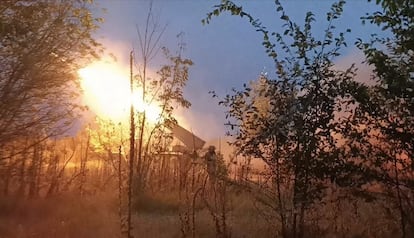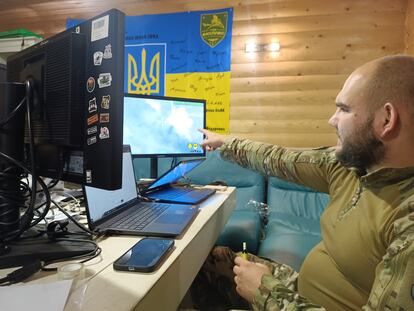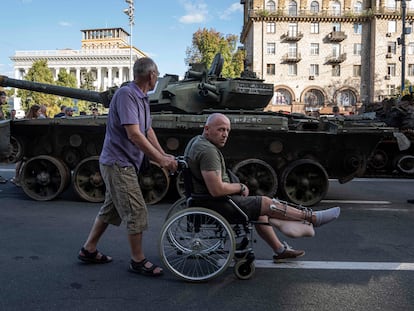Under the bombs in the Kupiansk bastion: Russia unleashes artillery while amassing infantry
The Ukrainian military warns that Moscow is replicating its strategy in Bakhmut to break the defenses of the strategic city while diverting forces from the counteroffensive in the south

Soldiers, local government employees and the occasional resident appear intermittently in the central square of Kupiansk to watch the fire of war. From this elevated position, in a city that is a military stronghold of the Kharkiv province in eastern Ukraine, a landscape is visible from which plumes of smoke rise every few minutes. The horizon is a mosaic of clouds of destruction, in every imaginable shade of gray. A Russian artillery barrage erupts some 10 miles away and three municipal gardeners taking advantage of a break exchange a few words, expectantly, as they scan the area occupied by the Ukrainian defenses. In a matter of seconds, smoke appears on the outskirts of Petropavlivka, a village a couple of miles away where the Ukrainian Army’s second line of trenches are located.
Russia is applying pressure on the Kupiansk front with artillery superiority and drones. It is the only enclave in Ukraine where the invading troops have gone on the offensive. Soldiers from eight different Ukrainian units interviewed last week by EL PAÍS said that Russian forces are attempting to take advantage of the Ukrainian counteroffensive on the southeastern front in Zaporizhzhia. Their aim is to retake this municipality, which is the gateway to the province of Kharkiv, a strategic target to close off a potential Ukrainian advance toward Russian-held Luhansk. Moscow is also using Kupiansk to force Kyiv to redirect troops from Zaporizhzhia, say senior Ukrainian battlefield commanders and officers consulted by this newspaper.
The panorama from the central square of Kupiansk resembles a board game of gigantic proportions. The result of the artillery exchange is perfectly identifiable and the sounds are clear: howitzer fire; the impact of shells; bursts of machine gun fire from Ukrainian units trying to shoot down Russian reconnaissance drones; the roar of an armored vehicle changing position at high speed. Where the Russian shells hit, the board game becomes a frightening reality, a lottery handing out tickets that decide life and death.
This lottery is played by the Grad rocket launcher unit commanded by Vladislav — he prefers not to provide a surname — of the 14th Mechanized Brigade. Soviet 152mm shells punish the area day and night. Vladislav’s jeep crosses burnt forests and still smoldering embers, to reach the forward point from where the Grad will fire on the Russian infantry. The operation lasts only 15 minutes. Then the Grad launcher the rest of the unit’s vehicles beat a hasty retreat to prevent enemy artillery from identifying their position.
A Ukrainian military truck is hidden in a grove of trees in Podoli, a village near Kupiansk. It is carrying a camouflaged Soviet ZSU-23 anti-aircraft machine gun, dating from the 1960s. A soldier continuously scans the sky with binoculars. The unit commander confirms that this weapon is not very effective against Russian Orlan reconnaissance drones, because they fly at a much higher altitude (around 15,000 feet) than the range of the ZSU-23. The commander says it is imperative Ukraine receives more German Gepard anti-aircraft machine guns and U.S. Patriot missile batteries. “[The Russians] control everything and are firing like crazy,” he says.

Sensei is the codename of a veteran Ukrainian infantry officer, who has been fighting since 2016 during the Donbas conflict. His men are stationed in Petropavlivka, but are constantly on the move. They are nervous and recommend the journalist leave the area as quickly as possible. The Russian lines are just 2,000 meters away: 15 minutes earlier, a short-range Mavik observation drone flew overhead and a few minutes later a shell hit. Sensei also notes that the main priority now is more anti-drone weapons.
The commanding general of the Ukrainian Ground Forces, Oleksandr Syrskyi, warned in August of increasing pressure on the 30-mile front between Kupiansk and Svatove, a municipality in Luhansk province bordering Kharkiv. Syrskyi confirmed that Ukrainian defenses were being reinforced because they had identified the deployment of eight new Russian assault battalions in the sector. The intelligence services of the Ukrainian Armed Forces have stated that the Kremlin is preparing to send 100,000 newly mobilized soldiers to this area of the front.
Criticism from Washington
Despite these warnings, the United States, Ukraine’s main ally and supplier of military hardware, has made it known through media such as The Washington Post and The New York Times that it does not agree with Kyiv’s strategy. In the view of the Pentagon, the Ukrainian Army should concentrate its efforts on the Zaporizhzhia front to advance toward the Sea of Azov and cut off supply lines to Russian troops on the southern front and in Crimea.
Kyiv has reacted angrily to this criticism. “Criticizing the slow pace of counteroffensive is the same as spitting into the face of Ukrainian soldier who sacrifices his life every day, moving forward and liberating one kilometer of Ukrainian soil after another,” said Foreign Minister Dmytro Kuleba at a meeting of EU foreign ministers in Spain. Last Thursday the Defense Ministry published a video along the same lines. “Now everyone is an expert on how we should fight,” it stated. “If we had listed to what non-Ukrainians were telling us in February 2022, we would no longer exist.”
Sensei sums up the complexity of the situation on the battlefield: “We have to watch all of the fronts, but it is true that the Russians’ weak point is in the south, in Zaporizhzhia. What they are doing here is distracting us but one thing is for sure; abandoning or losing a position is easy. Retaking it is much, much harder.”

Misha is a senior commander in the Kupiansk Territorial Defense Forces battalion. Speaking to EL PAÍS next to his van, which is riddled with bullet holes — “a souvenir of Bakhmut” he says with dark humor — he agrees with Syrskyi’s appraisal that the Russians are amassing infantry: “They are preparing something big,” he says.
While they are building up their infantry forces, the Russian offensive is based on artillery and drones to strike Ukrainian forces and their logistic and communication infrastructures, says Misha and other sources consulted. Misha is in no doubt that Kyiv must do whatever is necessary to defend the Kupiansk bastion, for three reasons: if it were to fall again (the city was in Russian hands between February and September 2022), the door would be open for an enemy advance on Kharkiv province; if Ukraine wants to liberate Luhansk, Kupiansk is an essential attack platform; and if Kupiansk were to be occupied again by Russian forces, he concludes, “it would be practically impossible to recover it.” Unlike in 2022, the Russians have erected a network of defenses that would make any counteroffensive a titanic feat.

The main responsibility for identifying enemy forces falls to drone units such as the one commanded by Gansk, an officer of the Achilles drone unit of the 92nd Ukrainian Mechanized Brigade. From their command base, Gansk and his men can observe the Russian trenches in real time.
Asked whether the enemy has the same capability, Gansk replies that they do. The advantage held by the Russians is that they have the state budget at their disposal, while the Ukrainians base much of their drone development projects on private donations, including from their own salaries. The Russian disadvantage is that their army is very hierarchical and any decision must go through Moscow, while Ukrainian units have autonomy to improve prototypes and explosives, Gansk explains in a secret underground workshop where he shows how his men adapt specific parts to load explosives adapted to each type of drone to be launched as bombs, aircraft parts produced with 3D printers, or prototypes of materials that are undetectable by radar.
Gansk, unlike many of his colleagues, who are aeronautical or computer engineers, is a former infantryman. His body bears numerous scars from a mine explosion. His combat experience gives him key analytical skills in deciphering what he sees from the air. And what he saw at the start of the offensive on Kupiansk a month ago are the same tactics Wagner’s mercenaries used to take Bakhmut last spring: “The Russian soldiers here are conscripts, they are not professionals, and, a month ago, at the height of infantry activity, they were following the same tactics as in Bakhmut: taking positions with waves of cannon fodder who don’t have sufficient protection or preparation.”
Nikola, a Bulgarian military veteran serving in a reconnaissance unit northwest of Kupiansk, also sees similarities with the Bakhmut offensive. Since February, he points out, the Russians have advanced only 2.5 miles and have remained in front of the Oskil River, a natural barrier protecting the town. “For Russian officers, the lives of their men are not worth anything. It’s a Soviet mentality. The groves on the other side of the river are full of rotting corpses, theirs and ours. They won’t let us evacuate ours, but they won’t remove theirs either, I imagine so that they won’t have to register them as casualties.”
Nikola explains that, despite all this, “the Russians are not stupid.” “Their goal is to freeze the conflict, to dig in where they are stronger and defend their territory. They advance 500 meters and dig trenches. And after a while, they go back to the same thing, even though it is a very slow strategy and despite the many deaths it entails.” The 48-year-old NATO-trained soldier believes it is highly unlikely that the Russians will retake Kupiansk, but they will do their best to shut off any future Ukrainian advance on Luhansk.
Sitting under a pear tree in an orchard in a village on the eastern fringes of Kharkiv, Nikola has the air of a warrior monk about him, with a high intellect. He concludes by warning of the risk of Ukraine’s allies believing that a negotiated peace may be possible. “My war with Russia began in 1944, when the Soviets came to my country and took it over. We have to convince the Americans and the Europeans that in Ukraine they won’t be able to kill two birds with one stone; they won’t be able to keep the Russians distracted and at the same time end the war. The Russians always come back.”
Sign up for our weekly newsletter to get more English-language news coverage from EL PAÍS USA Edition
Tu suscripción se está usando en otro dispositivo
¿Quieres añadir otro usuario a tu suscripción?
Si continúas leyendo en este dispositivo, no se podrá leer en el otro.
FlechaTu suscripción se está usando en otro dispositivo y solo puedes acceder a EL PAÍS desde un dispositivo a la vez.
Si quieres compartir tu cuenta, cambia tu suscripción a la modalidad Premium, así podrás añadir otro usuario. Cada uno accederá con su propia cuenta de email, lo que os permitirá personalizar vuestra experiencia en EL PAÍS.
¿Tienes una suscripción de empresa? Accede aquí para contratar más cuentas.
En el caso de no saber quién está usando tu cuenta, te recomendamos cambiar tu contraseña aquí.
Si decides continuar compartiendo tu cuenta, este mensaje se mostrará en tu dispositivo y en el de la otra persona que está usando tu cuenta de forma indefinida, afectando a tu experiencia de lectura. Puedes consultar aquí los términos y condiciones de la suscripción digital.
More information
Archived In
Últimas noticias
Most viewed
- Sinaloa Cartel war is taking its toll on Los Chapitos
- Oona Chaplin: ‘I told James Cameron that I was living in a treehouse and starting a permaculture project with a friend’
- Reinhard Genzel, Nobel laureate in physics: ‘One-minute videos will never give you the truth’
- Why the price of coffee has skyrocketed: from Brazilian plantations to specialty coffee houses
- Silver prices are going crazy: This is what’s fueling the rally











































